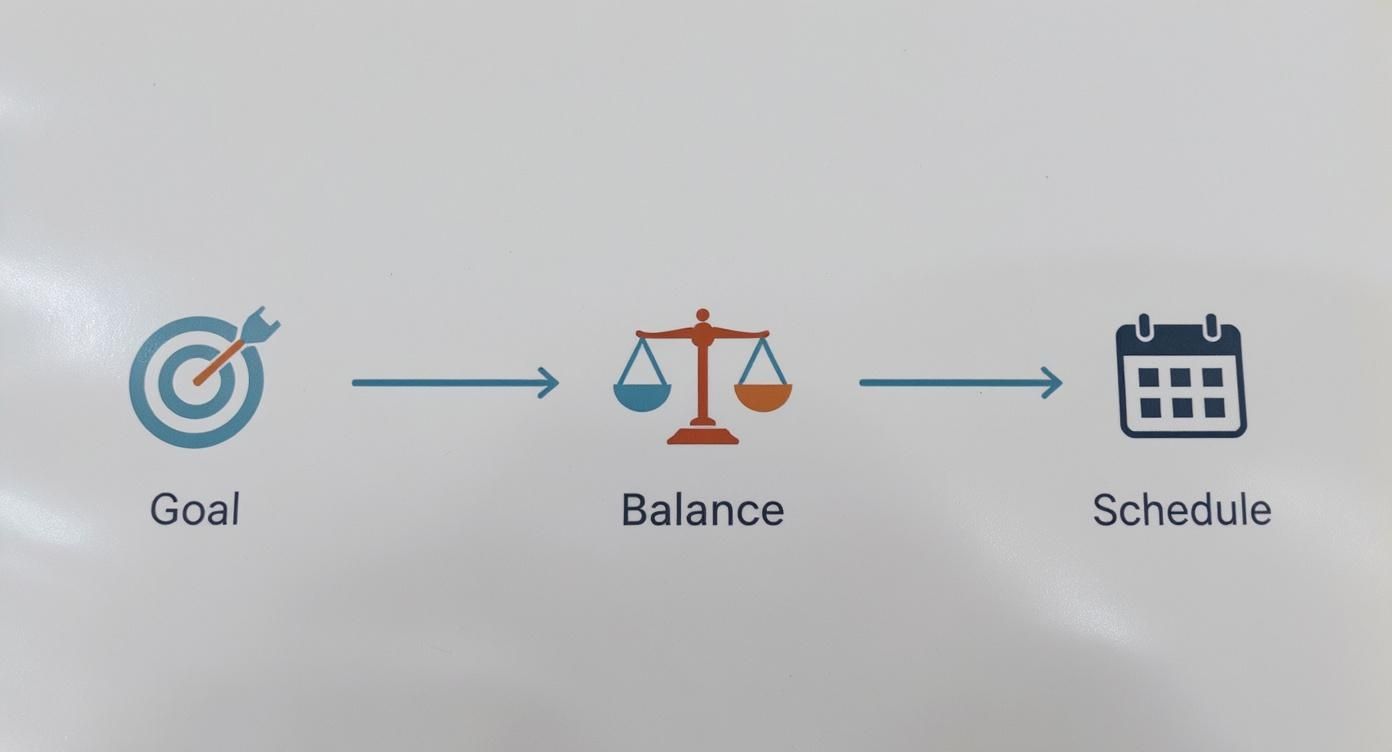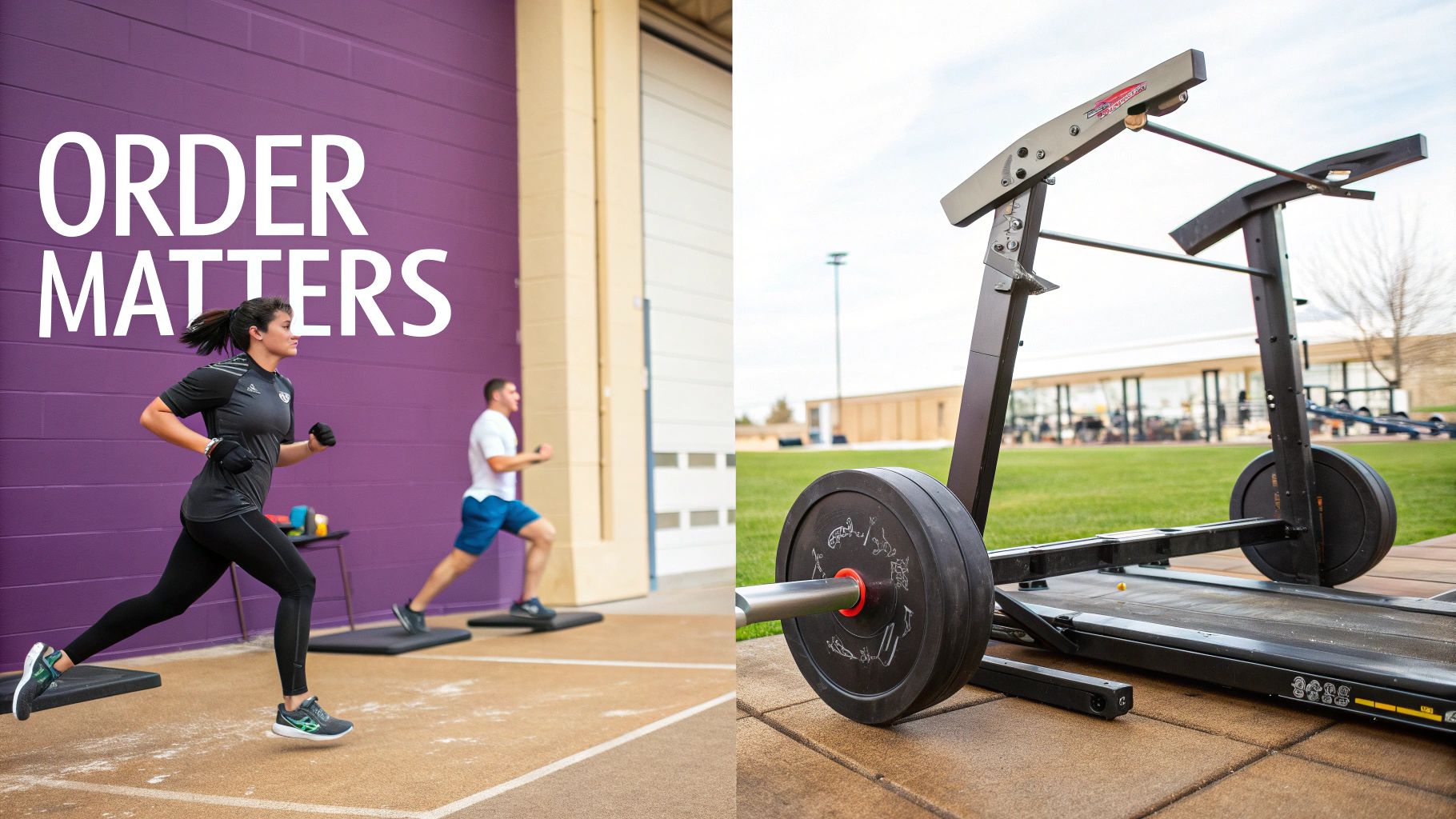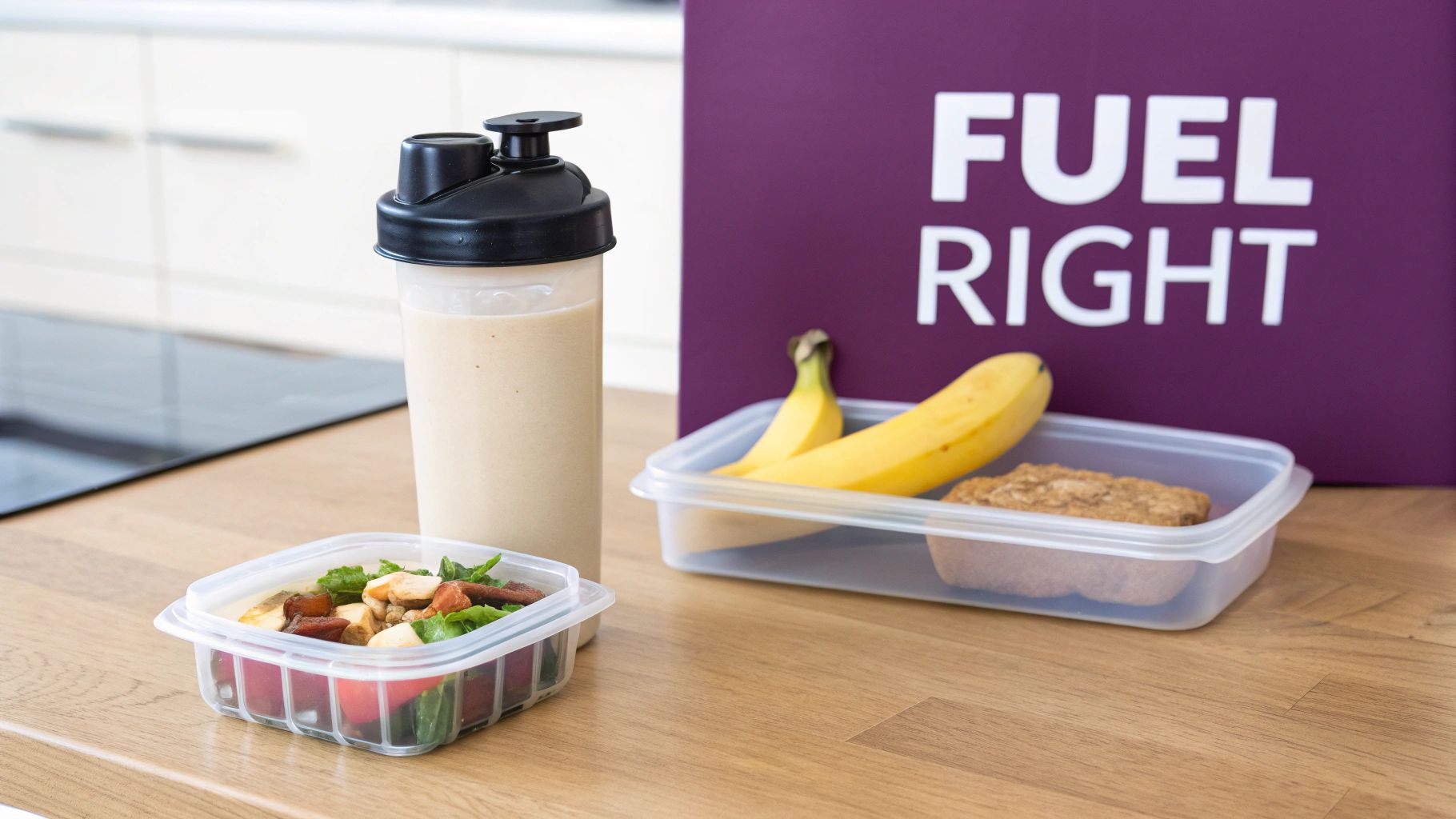
How to Balance Cardio and Strength Training for Results
Figuring out how to schedule cardio and strength training can feel like a puzzle. But it's not about picking one over the other—it's about making them work together for you.
The perfect balance really comes down to what you're trying to achieve. Are you aiming to lose fat, build muscle, or just feel healthier overall?
Combining them creates a synergy that’s way more powerful than doing either one alone.
Think of it this way: strength training builds a bigger, more efficient engine (your muscles), and cardio makes sure that engine runs smoothly and has the endurance to keep going.
The Winning Combination Your Body Needs
Before you start plugging workouts into your calendar, clarify your main objective. Your answer completely changes how you should structure your week.
When you get the mix right, you'll see faster results. Building more muscle through lifting naturally revs up your resting metabolism. This means your body burns more calories all day, even when you're resting.
Cardio then torches calories during the actual workout, creating a powerful one-two punch for fat loss. This combination of diet and exercise habits is key to achieving your fitness goals.
Finding the Right Mix for You
There’s no one-size-fits-all schedule. But for general fitness, a solid starting point is:
- 2-3 days of strength training per week, hitting all major muscle groups.
- 2-3 days of moderate-intensity cardio, aiming for 30-45 minutes each time.
This setup gives you the best of both worlds without running you into the ground. You can give each type of training its own day or stack them into one session.
A popular and effective way to do this is to tackle your strength workout first, then finish with a 20-30 minute cardio session.
Science backs this up. One study showed that adults who mixed aerobic and resistance training boosted their muscle strength by 15% more than the group doing only cardio, all while getting similar heart health benefits. You can read more about this winning health combination to dive into the details.
Remember, consistency will always beat intensity. A sustainable plan is your best bet for results that actually last.
Feeling good in what you're wearing can make all the difference in your motivation. Our collection of fitness-themed shirts and sweaters is designed to keep you inspired. These comfortable and stylish tops are perfect whether you're under a barbell or on the pavement, helping you look and feel your best.
To make it clearer, here’s a quick-glance table to help you tailor your week based on your goals.
Balancing Cardio and Strength Based on Your Goal
| Primary Goal | Strength Training Focus | Cardio Focus | Weekly Split Example |
|---|---|---|---|
| Fat Loss | 3-4 days/week. Prioritize compound lifts to maximize calorie burn and build muscle. | 2-3 days/week. Mix of HIIT and moderate-intensity sessions. | Mon: Strength, Tue: HIIT, Wed: Strength, Thu: Rest, Fri: Strength, Sat: Light Cardio, Sun: Rest. |
| Muscle Gain | 4-5 days/week. Main priority. Focus on progressive overload. | 1-2 days/week. Low-intensity sessions to support recovery and heart health without interfering with muscle growth. | Mon: Strength (Upper), Tue: Strength (Lower), Wed: Light Cardio/Rest, Thu: Strength (Upper), Fri: Strength (Lower), Sat/Sun: Rest. |
| General Health | 2-3 days/week. Full-body workouts. | 2-3 days/week. A variety of activities you enjoy (brisk walking, cycling, swimming). | Mon: Full-Body Strength, Tue: Cardio, Wed: Rest, Thu: Full-Body Strength, Fri: Cardio, Sat/Sun: Active Recovery. |
Use this as a starting point, listen to your body, and adjust as you go.
Designing Your Weekly Workout Schedule
The biggest hurdle for most people is figuring out how to fit everything in. Creating a schedule you can actually stick to is the real secret to making progress.
This visual guide breaks down how to think about your plan in three simple stages: nail down your goal, figure out the right mix, and then build a schedule that works.

As you can see, a solid plan always starts with a clear target. That target tells you how to arrange your workouts in your calendar.
The Alternate Day Approach
If you're starting out or want to give each workout your full attention, alternating days is a fantastic way to go.
The concept is simple: you have dedicated days for strength, dedicated days for cardio, and rest days in between.
- The upside? This gives you maximum recovery time. You can show up to your lifting day feeling fresh and tackle cardio without your legs feeling like jelly.
- The downside? It requires more days at the gym, which can be tough if your schedule is packed.
A classic week might look like this: Monday (Strength), Tuesday (Cardio), Wednesday (Rest), Thursday (Strength), and Friday (Cardio).
Combining Workouts for Maximum Efficiency
For those short on time, hybrid sessions are a game-changer. This is where you do both cardio and strength in the same workout.
Many people worry this will sabotage their progress, but the fear is often overblown.
Research found that combining aerobic exercise with heavy resistance training didn't hurt muscle gains. After 12 weeks, the group doing both saw an 18% increase in lower-body strength and gained lean mass—nearly identical results to the strength-only group. They also improved their VO2 max by 10%. You can discover more about these findings on combined training.
The bottom line is that you have a lot more flexibility in scheduling your workouts than you might think, without compromising your results.
When you're doing these hybrid sessions, having versatile equipment makes a world of difference. Our Premium Resistance Bands are perfect for this. They are incredibly versatile for both strength and cardio workouts. Use them for activation exercises to warm up your muscles before lifting, or weave them into a high-energy cardio finisher at the end. They pack a serious punch in a short amount of time, making them a must-have for any home or gym routine.
Cardio or Strength First: Which is Better?

You’ve made it to the gym, ready for weights and cardio. Now comes the classic question: what first? The order you choose can make a huge difference.
If your main goal is to build muscle or hit a new personal best, hit the weights first.
Heavy lifting demands a ton of energy. Doing a long cardio session beforehand drains your fuel tanks. When you get to the squat rack, your muscles are already fatigued, which can hurt your performance and form.
When Cardio First Makes Sense
Of course, there are times when leading with cardio is the smarter move. If you're training for a 5K, your run should be the star of the show.
A light cardio session also works as a perfect warm-up. A simple 5 to 10-minute jog gets the blood pumping and preps your body for the workout ahead without tiring you out.
Key Takeaway: Let your primary goal for the day decide the order. Prioritize what's most important while you're at your freshest.
Let’s look at how this plays out:
- On Leg Day: Your goal is strength. Start with heavy squats and finish with a cool-down walk.
- On an Active Recovery Day: Your focus is on blood flow. A gentle 20-30 minutes of cycling before stretching would be perfect.
- On a HIIT Day: Some workouts are designed to mix things up. If you're curious, you can learn more about what HIIT training is and see how it blends both into one session.
Fueling Your Body for a Balanced Routine
You can have the perfect workout plan, but what you do in the kitchen is what truly unlocks your results. Proper nutrition is the secret sauce that holds your training program together.

Think of food as premium fuel. Trying to train without it is like running a car on empty—you’ll stall out, leading to fatigue and subpar workouts.
When you’re balancing two different training styles, the two most important players are protein and carbohydrates. Protein is the cornerstone for muscle repair, while carbs are the energy you need to power through a tough workout. For a deeper dive, check out our guide on what to eat when exercising.
Pre and Post Workout Nutrition
Timing your nutrition can make a huge difference. Before a workout, I recommend a meal rich in complex carbs about 60-90 minutes beforehand. This provides the sustained energy you’ll need to finish strong.
After you’re done, your priority is recovery. A meal or shake with fast-digesting protein and carbs is perfect for replenishing your energy stores and kickstarting muscle repair.
A fascinating clinical trial drove this point home. Researchers found that while both cardio-only and combined training groups lost similar amounts of fat, the group doing both saw a 20% improvement in insulin sensitivity. That's double the benefit of the cardio group! It’s clear proof that a balanced routine supported by smart nutrition delivers far superior metabolic health. You can read the full research about these metabolic findings.
To keep things simple, a high-quality protein shake is a lifesaver post-workout. Our All-in-One Protein Superblend is specifically designed to support muscle growth and recovery. It provides the critical nutrients your muscles need after a tough session, making your recovery effortless and helping you achieve your fitness goals faster.
For real-world ideas, check out our Diet & Exercise YouTube video on 'What I Eat in a Day' for inspiration.
Listening to Your Body and Avoiding Overtraining
When balancing cardio and strength, it's easy to fall into the "more is always better" trap. Pushing your body past its limits without enough recovery is a one-way ticket to a plateau or injury.
The key to long-term progress is consistency, not just grinding it out every day.
If you're constantly wiped out, your lifts are stalling, or you have nagging aches, your body is sending you a clear message. It’s screaming for a break.
Smart Recovery Strategies
Ignoring those signals is a mistake. Instead, get proactive about your recovery.
Here’s what works:
- Active Recovery Days: Don't just sit on the couch. A light walk or gentle bike ride gets blood flowing and eases muscle soreness.
- Prioritize Sleep: This is non-negotiable. Aim for 7-9 hours of solid sleep a night. It's when your body releases growth hormone and repairs muscle tissue.
- Plan a Deload Week: Every 4-6 weeks, pull back. Reduce your weights or shorten your sessions to let your body fully recharge.
Remember, recovery is where the magic happens. You don't get stronger in the gym; you get stronger when you rest.
The right tools can make a huge difference. A good foam roller, like our 'Smart Recovery' Foam Roller, is a game-changer. It is an essential tool for anyone serious about their fitness. Using it after a workout helps break up muscle knots, boosts flexibility, and cuts down on soreness. This simple step helps you show up to your next session ready to go, not hobbling in pain.
Your Top Cardio and Strength Questions, Answered
Starting a new fitness plan can be confusing. Let's clear up some common questions so you can build your schedule with confidence.
How Many Days a Week Should I Train to Lose Weight?
For weight loss, aim for 2-3 days of strength training and 2-3 days of moderate cardio each week.
Strength training builds lean muscle, which revs up your metabolism. Cardio helps create the immediate calorie deficit needed to shed fat. Combining these with a healthy diet is the most effective strategy.
If you’re pressed for time, you can stack them on the same day—just hit the weights first.
Is It Okay to Lift Weights and Do Cardio on the Same Day?
Yes, it is. Combining workouts is a super-efficient way to get it all in.
If getting stronger is your top priority, always lift weights first. This way, you’re tackling the most demanding part with a full tank of energy. Then, finish with cardio.
But if endurance is your focus, it's fine to lead with cardio.
The Bottom Line: The best routine is the one you actually stick to. Consistency is what ultimately gets you the results you want.
Will Too Much Cardio Kill My Muscle Gains?
This is a classic gym debate. An excessive amount of intense cardio could potentially slow down muscle growth.
But for most of us, a moderate amount will actually help. Good cardio supports recovery and builds your overall work capacity, meaning you can push harder during your lifts.
Aim for 2-3 cardio sessions of 20-45 minutes a week. On heavy lifting days, opt for lower-impact cardio like cycling or walking on an incline to avoid extra stress on your muscles.
At Diet & Exercise, we think your workout gear should be as fun and inspiring as your fitness goals. We've designed a whole line of awesome fitness-themed shirts and sweaters to keep you fired up. Check out our collection and wear your passion with pride.
